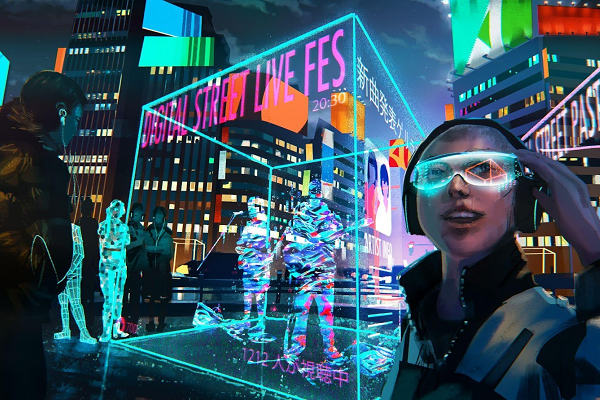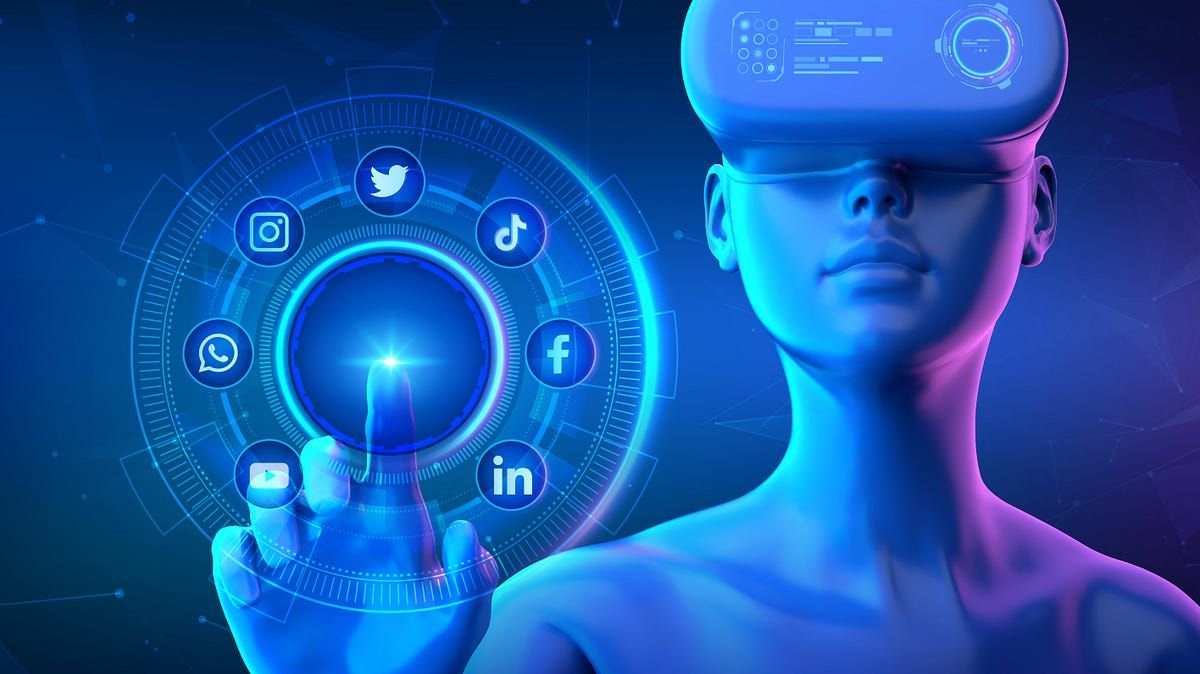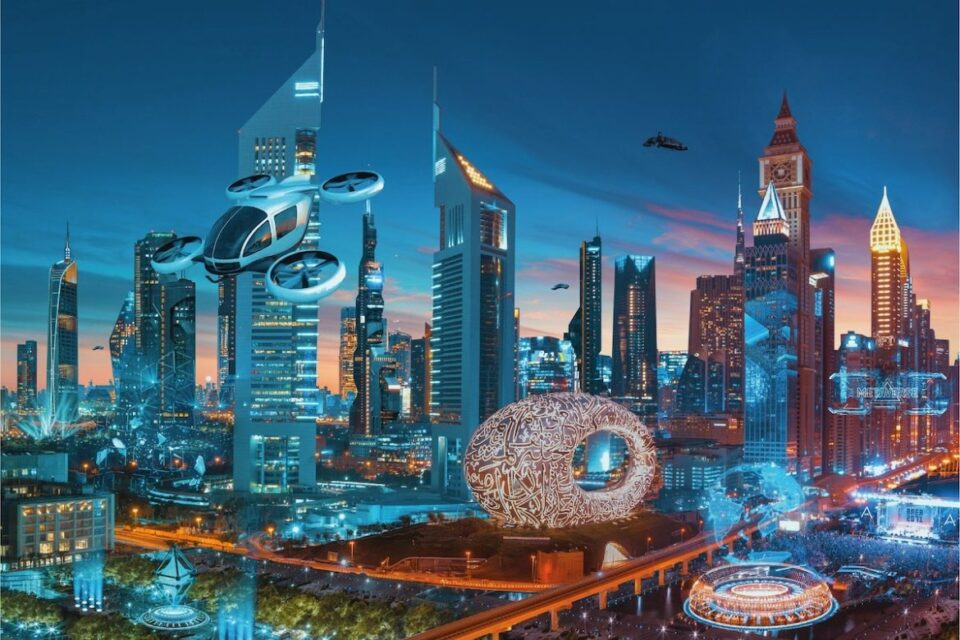The concept of the metaverse, once confined to the pages of science fiction, is rapidly materializing into a tangible reality, promising to revolutionize how we interact, work, play, and socialize. More than just a virtual reality game or a 3D website, the metaverse envisions a persistent, interconnected network of virtual worlds, real-time 3D environments, and digital assets, all seamlessly integrated with our physical lives. It’s a grand ambition to create a shared, embodied digital space that transcends current internet limitations, offering an unprecedented level of immersion, interactivity, and economic opportunity. This profound shift is no longer a distant dream but an active construction, bringing the virtual future into our present moment.
Understanding the Dawn of the Metaverse: Beyond Screens
To fully grasp the magnitude of the metaverse, it’s crucial to understand what sets it apart from existing digital experiences and how it represents the next evolutionary leap of the internet.
A. The Internet’s Evolution: From Information to Immersion
Our journey to the metaverse is a natural progression of how we engage with digital information and each other.
- Web 1.0: The Static Information Age: The early internet was primarily a collection of static web pages, focused on delivering information. Interaction was minimal, akin to reading an online book. Users were largely consumers of content.
- Web 2.0: The Social and Interactive Web: This era brought user-generated content, social media platforms, e-commerce, and mobile applications. It fostered connectivity and interactivity, allowing users to create, share, and connect. However, interactions remained largely two-dimensional, confined to screens.
- The Metaverse: Embodied and Persistent Digital Worlds: The metaverse aims to go beyond flat screens. It promises an embodied internet where users exist as avatars in persistent 3D virtual environments. This creates a sense of presence, allowing for richer, more natural interactions that mimic real-world experiences. It’s not just using the internet; it’s being in the internet.
B. Distinguishing the Metaverse: Key Qualities
While components of the metaverse exist today (like online games or VR experiences), a true metaverse embodies several distinguishing qualities:
- Persistence: Unlike a game that ends or a website you close, the metaverse never truly ‘resets’ or ‘ends.’ It continues to exist and evolve, even when you’re not in it, much like the physical world. Your actions and creations remain.
- Synchronicity: Interactions within the metaverse happen in real-time. Users can simultaneously experience and participate in events, meetings, or social gatherings, fostering a sense of shared presence.
- Interoperability: This is a crucial, though challenging, aspect. It means that digital assets (avatars, items, properties) and identities can seamlessly transfer between different virtual worlds or platforms within the metaverse. This avoids current ‘walled garden’ limitations.
- Economic System: A fully functional metaverse includes a robust, user-driven economy, often powered by cryptocurrencies and NFTs (Non-Fungible Tokens), allowing users to create, own, buy, and sell digital goods and services.
- Embodied Experience: Users engage with the metaverse through avatars, giving them a sense of presence and embodiment within the virtual space, enabling more intuitive and immersive interactions than traditional screen-based interfaces.
- Decentralization (Ideal): Many proponents envision a decentralized metaverse, built on blockchain technology, where no single entity controls the entire platform, giving users greater ownership and control over their data and assets.
Core Technologies Powering the Metaverse
The construction of the metaverse relies on a complex interplay of cutting-edge technologies, each contributing a vital piece to the grand vision.
A. Virtual Reality (VR) and Augmented Reality (AR)
These immersive technologies are the primary gateways into the metaverse, providing varying degrees of digital immersion.
- Virtual Reality (VR): VR headsets (e.g., Meta Quest, Apple Vision Pro, Valve Index) provide full immersion by replacing the user’s view of the real world with a simulated digital environment. This is crucial for deeply immersive experiences like virtual meetings, gaming, or simulated training.
- Augmented Reality (AR): AR overlays digital information and objects onto the real world (e.g., through smartphone cameras or smart glasses). This blends digital elements with physical reality, enhancing our perception and interaction with the physical world (e.g., navigation overlays, interactive product views).
- Extended Reality (XR): This is an umbrella term encompassing VR, AR, and Mixed Reality (MR), representing the full spectrum of immersive technologies that will be integral to metaverse access and interaction.
- Haptic Feedback: Haptic suits and gloves provide tactile sensations, allowing users to ‘feel’ digital objects or environments, further enhancing immersion and interaction realism within the metaverse.
B. Blockchain and Non-Fungible Tokens (NFTs)
Blockchain technology is fundamental to enabling ownership, decentralization, and a functional economy within the metaverse.
- Decentralized Ownership (NFTs): NFTs are unique digital tokens on a blockchain that prove ownership of digital assets (e.g., virtual land, avatar skins, unique items). This allows users to truly own their digital property, facilitating a real economy.
- Cryptocurrencies: Digital currencies (e.g., Ethereum, Bitcoin, or metaverse-specific tokens) enable secure and transparent transactions within the metaverse economy, allowing users to buy, sell, and trade digital goods and services.
- Identity and Avatars: Blockchain can secure digital identities and avatars, ensuring that a user’s presence and reputation can persist across different metaverse platforms.
- Smart Contracts: Self-executing contracts stored on a blockchain automate agreements and transactions without intermediaries, powering complex economic interactions and governance within virtual worlds.
C. 3D Modeling and Rendering Technologies
The visual fidelity and immersive nature of the metaverse depend heavily on advanced 3D technologies.
- Real-time 3D Engines: Powerful game engines like Unreal Engine and Unity are crucial for rendering complex 3D environments and avatars in real-time, enabling seamless and interactive experiences.
- Photogrammetry and Lidar: These technologies allow for the creation of highly realistic 3D models of real-world objects and environments by scanning them, blurring the line between the physical and virtual.
- Volumetric Video: Capturing and rendering 3D video allows for realistic human presence in virtual spaces, going beyond flat video calls.
- User-Generated Content (UGC) Tools: Accessible tools that allow users to create and customize their own 3D assets, avatars, and even virtual environments, fostering a vibrant, creative economy.
D. High-Speed Connectivity (5G and Beyond)
The sheer volume of real-time data required for a persistent, immersive metaverse necessitates robust, high-speed, and low-latency network infrastructure.
- 5G Networks: The current generation of 5G provides significantly higher bandwidth and lower latency compared to 4G, making real-time streaming of complex 3D environments and multiple user interactions feasible.
- Future Network Technologies (6G, Satellite Internet): As the metaverse scales and demands even greater fidelity and user concurrency, next-generation networks like 6G and advanced satellite internet will be crucial for ubiquitous, high-performance connectivity.
- Edge Computing: Processing data closer to the user (at the network edge) reduces latency, enhancing the responsiveness and realism of metaverse interactions.
E. Artificial Intelligence (AI)
AI will serve as the intelligence layer within the metaverse, enhancing experiences and driving functionality.
- NPCs and Virtual Agents: AI will power intelligent Non-Player Characters (NPCs) and virtual agents, allowing for more realistic interactions and dynamic virtual populations.
- Content Generation: Generative AI can create virtual worlds, assets, textures, and even music on the fly, significantly reducing the manual effort in building vast metaverse environments.
- Personalization: AI will personalize user experiences within the metaverse, tailoring content, recommendations, and interactions based on individual preferences and behavior.
- Moderation and Safety: AI will assist in monitoring and moderating user behavior, identifying harmful content, and ensuring a safer environment within the vast virtual spaces.
Transformative Impacts of the Metaverse: Redefining Human Interaction
The metaverse is not just a technological curiosity; it holds the potential to profoundly transform fundamental aspects of human interaction, commerce, and culture.
A. Revolutionizing Social Interaction and Community Building
The metaverse offers a new dimension for social connection, moving beyond flat video calls or text chats to embodied, shared experiences.
- Immersive Social Spaces: Users can meet friends, attend concerts, visit virtual landmarks, or participate in group activities in shared 3D spaces, creating a stronger sense of presence and connection than current social media.
- Global Communities: The metaverse can foster global communities around shared interests, passions, or professional networks, transcending geographical boundaries.
- New Forms of Self-Expression: Avatars allow for unprecedented customization and self-expression, empowering users to represent themselves in diverse ways, fostering inclusivity and creativity.
- Hybrid Events: Blending physical and virtual presence, the metaverse can host hybrid events where participants can join from anywhere in the world, fostering broader access and participation.
B. Redefining Work and Collaboration
The future of work is poised for significant disruption, with the metaverse offering new paradigms for collaboration and productivity.
- Immersive Virtual Workspaces: Teams can meet in persistent 3D virtual offices, collaborating on projects, reviewing 3D models, or conducting training simulations in highly engaging environments. This can foster greater presence and team cohesion for remote workforces.
- Training and Simulation: High-fidelity Digital Twins within the metaverse can offer realistic training environments for surgeons, engineers, or emergency responders, allowing practice in risk-free virtual settings.
- Remote Operations and Digital Twins: Engineers can use Digital Twins in the metaverse to remotely monitor, diagnose, and even operate physical machinery or infrastructure, blurring the lines between physical and virtual control.
- Borderless Talent Pools: Companies can access a global talent pool, bringing together experts from around the world to collaborate in shared virtual spaces, regardless of physical location.
C. Transforming Commerce and Economic Models
The metaverse introduces entirely new economic models and avenues for commerce, expanding beyond traditional e-commerce.
- Digital Economies and Virtual Goods: Users can buy, sell, and trade digital assets (avatar clothes, virtual land, unique items) within metaverse platforms, creating a vibrant, multi-billion dollar virtual economy powered by NFTs and cryptocurrencies.
- New Business Models: Companies can establish virtual storefronts, host immersive shopping experiences, or offer unique digital products and services tailored for the metaverse environment.
- Creator Economy: The metaverse empowers a new wave of digital creators—artists, developers, designers—who can build, monetize, and sell their virtual creations directly to users, fostering a robust creator-driven economy.
- Advertising and Marketing: Brands will explore new, immersive advertising and marketing strategies within virtual worlds, creating interactive brand experiences rather than just displaying static ads.
D. Revolutionizing Education and Learning
The immersive nature of the metaverse offers unparalleled opportunities for engaging and effective learning.
- Immersive Learning Environments: Students can visit historical sites virtually, conduct scientific experiments in simulated labs, or explore complex anatomical models in 3D, making learning more experiential and engaging.
- Interactive Training: Complex skills can be practiced in realistic virtual simulations, from surgical procedures to operating heavy machinery, providing hands-on experience without real-world risk.
- Global Classrooms: Students and educators from around the world can connect in shared virtual classrooms, fostering diverse perspectives and collaborative learning experiences.
- Gamified Education: Learning can be integrated into engaging virtual games and challenges, increasing motivation and retention.
E. Expanding Entertainment and Arts
The metaverse is poised to become a boundless canvas for new forms of entertainment and artistic expression.
- Immersive Gaming: Beyond traditional video games, the metaverse enables persistent, open-world gaming experiences where players’ actions have lasting impacts on the virtual world.
- Virtual Concerts and Events: Artists can host massive virtual concerts, festivals, or performances that can be attended by millions globally, offering unique interactive elements and visual spectacle.
- New Art Forms: Artists can create interactive 3D sculptures, virtual galleries, and immersive narrative experiences that transcend the limitations of physical spaces.
- Digital Storytelling: Storytellers can build elaborate virtual worlds and narratives that users can explore and influence, creating highly personalized and interactive storytelling experiences.
Navigating the Challenges and Ethical Dilemmas of the Metaverse
Despite its immense promise, the path to a fully realized metaverse is fraught with significant technical, ethical, and societal challenges that demand careful consideration and proactive solutions.
A. Technical and Infrastructure Hurdles
Building and scaling a truly interoperable and persistent metaverse is a monumental technical undertaking.
- Massive Computing Power: Rendering photorealistic 3D environments in real-time for millions of concurrent users requires unprecedented levels of distributed computing power and graphical processing, far exceeding current capabilities.
- Network Bandwidth and Latency: The sheer volume of real-time data (3D models, sensor data, haptics, multi-user interactions) will demand ultra-high bandwidth and extremely low latency networks (beyond current 5G) to prevent lag and ensure a seamless, synchronous experience.
- Interoperability Standards: Achieving true interoperability—where avatars, items, and identities can seamlessly move between different virtual worlds developed by different companies—requires universal standards that are currently nascent and challenging to agree upon. This is a major hurdle against ‘walled garden’ metaverses.
- Hardware Accessibility and Cost: High-fidelity VR/AR headsets are still relatively expensive and often require powerful PCs. Making immersive hardware affordable and accessible to the mass market is crucial for broad adoption.
- Energy Consumption: The vast computational resources required for the metaverse raise concerns about its environmental footprint and energy consumption, demanding sustainable infrastructure solutions.
B. Data Privacy, Security, and Identity
The highly immersive and data-intensive nature of the metaverse introduces unprecedented challenges for privacy, security, and digital identity.
- Personal Data Collection: Metaverse platforms will collect vast amounts of highly personal data, including biometric data, movement patterns, emotional responses (via facial tracking), and detailed behavioral data. Protecting this data from misuse, breaches, and unauthorized access is a critical concern.
- Digital Identity and Avatars: Ensuring secure and verifiable digital identities in the metaverse, preventing identity theft, and allowing users control over their avatar’s representation and data are complex issues.
- Cybersecurity Threats: The metaverse will become a new frontier for cybercrime, including phishing, scams, ransomware, virtual property theft, and even ‘virtual assault,’ requiring robust security protocols and law enforcement.
- Deepfakes and Misinformation: The ability to create highly realistic digital content and avatars could exacerbate issues of deepfakes, misinformation, and impersonation, making it harder to distinguish reality from fabrication.
C. Ethical and Societal Implications
Beyond the technical, the metaverse raises profound ethical and societal questions that need proactive consideration and governance.
- Digital Addiction and Mental Health: The immersive nature of the metaverse could lead to increased digital addiction, social isolation in the physical world, and potential negative impacts on mental health, especially for vulnerable populations.
- Digital Inequality: Access to the metaverse (hardware, connectivity) could create new forms of digital divides, exacerbating existing inequalities and creating a two-tiered society where some are more ‘connected’ and empowered than others.
- Content Moderation and Harmful Behavior: Policing vast, persistent virtual worlds for harmful content (hate speech, harassment, graphic content, extremism) will be incredibly challenging, requiring scalable AI tools and human oversight.
- Economic Disparity: While the metaverse promises new economic opportunities, concerns exist about who will truly benefit, potential for speculative bubbles (e.g., in virtual land), and widening wealth gaps between digital ‘haves’ and ‘have-nots.’
- Governance and Regulation: Who sets the rules for behavior, commerce, and content in the metaverse? National laws may struggle to apply across borderless virtual worlds, necessitating new forms of global governance and self-regulation.
- Human Rights in Virtual Spaces: Ensuring human rights (e.g., freedom of expression, assembly, non-discrimination) are protected in virtual environments, and defining accountability for violations, will be a critical challenge.
D. Intellectual Property and Digital Rights Management
The ease of creating and sharing digital content in the metaverse brings significant challenges for intellectual property.
- Copyright Enforcement: Protecting copyrighted materials (music, art, designs) in a decentralized, user-generated content metaverse will be complex.
- Trademark Infringement: Brands face challenges protecting their trademarks in virtual spaces from unauthorized use or counterfeiting of digital goods.
- Digital Rights Management (DRM): Ensuring artists and creators are fairly compensated for the use and resale of their digital assets in virtual economies.
Best Practices for Building and Engaging in the Metaverse
To ensure the metaverse develops into a positive and beneficial extension of our lives, stakeholders—from developers and businesses to policymakers and users—must adhere to a set of best practices.
A. Prioritize User Safety and Wellbeing
The most critical best practice is to design and operate metaverse platforms with user safety and wellbeing at their core.
- Robust Moderation: Implement strong content moderation policies and effective tools (AI and human) to combat harassment, hate speech, and other harmful behaviors.
- Privacy by Design: Embed privacy considerations into the architecture from the ground up, giving users granular control over their data.
- Digital Wellbeing Features: Offer tools that help users manage screen time, take breaks, and maintain a healthy balance between virtual and physical lives.
- Age-Appropriate Experiences: Develop age verification mechanisms and create separate, safe environments for children and young users.
B. Champion Openness and Interoperability
To prevent the metaverse from becoming a collection of disjointed ‘walled gardens,’ openness and interoperability must be championed.
- Standardization: Actively participate in and promote the development of open standards for avatars, digital assets, identities, and virtual world data.
- Cross-Platform Compatibility: Design platforms to be compatible with a wide range of hardware and software, reducing barriers to entry.
- Data Portability: Enable users to easily transfer their data, assets, and identities between different metaverse platforms, fostering competition and user control.
C. Build Inclusive and Diverse Worlds
The metaverse has the potential to be truly global and inclusive. Design should reflect this.
- Diverse Avatar Customization: Offer extensive options for avatar customization that represent a wide range of ethnicities, body types, abilities, and gender identities.
- Accessible Design: Ensure metaverse experiences are accessible to users with disabilities, integrating features like voice commands, haptic feedback for navigation, and options for reduced motion.
- Global Cultural Sensitivity: Design virtual environments and content that respect and celebrate diverse cultures, avoiding biases or cultural appropriation.
D. Foster a Robust and Fair Creator Economy
The metaverse thrives on user-generated content. Empowering creators is key.
- Easy-to-Use Creation Tools: Provide intuitive and accessible tools that allow users (not just professional developers) to create and monetize their own digital assets, experiences, and virtual properties.
- Fair Monetization Models: Establish transparent and equitable revenue-sharing models for creators, ensuring they are fairly compensated for their contributions, including resale royalties for NFTs.
- Strong IP Protection: Develop robust mechanisms for protecting intellectual property rights and digital rights management, allowing creators to secure their work and prevent unauthorized copying or use.
E. Develop Clear Governance and Ethical Guidelines
As an emerging domain, the metaverse requires thoughtful governance.
- Community-Driven Governance: Explore decentralized autonomous organizations (DAOs) and other community-driven governance models to allow users to have a say in the rules and evolution of metaverse platforms.
- Legal Framework Collaboration: Policymakers, industry leaders, and legal experts must collaborate to develop new legal frameworks that address property rights, liability, data privacy, and other legal issues unique to the metaverse.
- Ethical AI Development: Ensure AI models used within the metaverse are developed ethically, free from bias, and with transparency in their decision-making processes, particularly for moderation or personalized experiences.
F. Design for Sustainability and Energy Efficiency
Given the vast computational demands, sustainability must be a core design principle.
- Green Infrastructure: Prioritize green data centers and renewable energy sources for powering metaverse infrastructure.
- Efficient Rendering: Optimize 3D engines and rendering techniques to reduce computational power consumption.
- Blockchain Optimization: Favor energy-efficient blockchain consensus mechanisms (e.g., Proof-of-Stake over Proof-of-Work) for metaverse economies.
G. Focus on Real Value and Utility, Not Just Hype
While the metaverse is exciting, its long-term success depends on delivering tangible value and utility to users, not just speculative hype. Focus on use cases that genuinely enhance human connection, productivity, learning, and entertainment in ways that current technologies cannot.
The Future Trajectory of the Metaverse: An Unfolding Reality
The metaverse is not a singular product but a sprawling, evolving concept. Its future trajectory will be shaped by continuous technological breakthroughs, evolving societal needs, and ongoing governance debates.
A. Pervasive Immersion and Seamless Blending of Realities
The distinction between physical and virtual will increasingly blur.
- Advanced AR Glasses: Lightweight, comfortable, and aesthetically pleasing AR glasses will become commonplace, seamlessly overlaying digital content onto our real world, making digital information ubiquitous and contextual.
- Neurological Interfaces: Long-term research points towards brain-computer interfaces (BCIs) that could allow for direct thought control and even sensory input into the metaverse, offering unprecedented levels of immersion and interaction.
- Physical-Digital Integration: The metaverse will integrate more deeply with physical objects and spaces through IoT and Digital Twins, creating truly hybrid environments where digital twins of real-world assets exist and operate in the metaverse.
B. Decentralization and User Empowerment
The vision of a truly open, decentralized metaverse will likely gain momentum, driven by blockchain technology.
- DAO-Led Metaverses: More metaverse platforms will adopt Decentralized Autonomous Organization (DAO) structures, empowering communities to govern and evolve the virtual worlds they inhabit.
- True Digital Ownership: Blockchain and NFTs will solidify user ownership of digital assets, leading to thriving, liquid virtual economies that are more resilient to centralized control.
- Self-Sovereign Identity: Users will have greater control over their digital identities and personal data, deciding what information they share and with whom, fostering trust and privacy.
C. AI as a Fundamental Co-Creator and Agent
AI will become an even more integral and sophisticated component of the metaverse.
- Autonomous AI Agents: AI-powered virtual beings will populate the metaverse, acting as intelligent companions, personalized assistants, or highly realistic NPCs, capable of complex conversations and adaptive behaviors.
- Real-time Content Generation: Generative AI will create dynamic, evolving virtual environments, stories, and personalized content on the fly, making every metaverse experience unique.
- Predictive and Prescriptive AI: AI will predict user needs, suggest interactions, and optimize experiences in real-time, making the metaverse highly intuitive and responsive.
D. Specialized Metaverses and Interconnected Experiences
Instead of a single, monolithic metaverse, we will likely see a proliferation of specialized metaverses catering to specific niches, eventually becoming interconnected.
- Enterprise Metaverses: Virtual spaces dedicated to corporate training, product design, remote collaboration, and industrial operations.
- Educational Metaverses: Immersive learning environments for specific subjects or vocational training.
- Cultural Metaverses: Virtual museums, historical recreations, and artistic performance spaces. These specialized metaverses will gradually establish interoperable bridges, allowing users to move between them, forming a broader, federated metaverse.
E. Evolving Regulatory and Ethical Frameworks
Governments and international bodies will develop more comprehensive regulatory and ethical frameworks specifically for the metaverse.
- Digital Property Laws: Clearer laws regarding ownership, inheritance, and taxation of virtual assets.
- Safety and Harm Prevention: Regulations addressing online harassment, digital assault, and the protection of vulnerable users.
- Data Governance Standards: Stricter rules for data collection, usage, and privacy within immersive environments.
- Sustainable Metaverse Development: Policies and incentives to encourage the development of energy-efficient metaverse infrastructure and responsible resource consumption.
Conclusion
The metaverse, once a distant vision, is rapidly transitioning into a tangible reality, shaping the very essence of our digital future today. It represents an ambitious and transformative leap beyond the current internet, promising a persistent, interconnected network of embodied virtual worlds that redefine how we socialize, work, learn, and engage in commerce. This shift is driven by the synergistic power of virtual and augmented reality, blockchain technology, advanced 3D rendering, high-speed connectivity, and sophisticated artificial intelligence.
While the journey to a fully realized metaverse is fraught with formidable challenges—ranging from technical infrastructure hurdles and complex interoperability standards to profound ethical dilemmas concerning privacy, security, and digital inequality—its potential benefits are too compelling to ignore. By embracing best practices rooted in user safety, openness, inclusivity, and responsible innovation, stakeholders can guide its development towards a future that truly augments human experience and unlocks unprecedented opportunities. The metaverse is not just coming; it is being built now, inviting us to step beyond our screens and into a vibrant, immersive digital frontier, truly unveiling the virtual future now.














